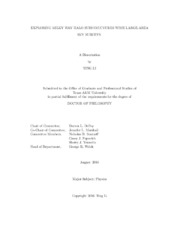| dc.description.abstract | Over the last two decades, our understanding of the Milky Way has been improved thanks to large data sets arising from large-area digital sky surveys. The stellar halo is now known to be inhabited by a variety of spatial and kinematic stellar substructures, including stellar streams and stellar clouds, all of which are predicted by hierarchical Lambda Cold Dark Matter models of galaxy formation.
In this dissertation, we first present the analysis of spectroscopic observations of individual stars from the two candidate structures discovered using an M-giant catalog from the Two Micron All-Sky Survey. The follow-up observations show that one of the candidates is a genuine structure which might be associated with the Galactic Anticenter Stellar Structure, while the other one is a false detection due to the systematic photometric errors in the survey or dust extinction in low Galactic latitudes.
We then presented the discovery of an excess of main sequence turn-off stars in the direction of the constellations of Eridanus and Phoenix from the first-year data of the Dark Energy Survey (DES) - a five-year, 5,000 deg^2 optical imaging survey in the Southern Hemisphere. The Eridanus-Phoenix (EriPhe) overdensity is centered around l - 285⁰ and b - -60⁰ and the Poisson significance of the detection is at least 9σ. The EriPhe overdensity has a cloud-like morphology and the extent is at least 4 kpc by 3 kpc in projection, with a heliocentric distance of about d - 16 kpc. The EriPhe overdensity is morphologically similar to the previously-discovered Virgo overdensity and Hercules-Aquila cloud. These three overdensities lie along a polar plane separated by 120⁰ and may share a common origin.
In addition to the scientific discoveries, we also present the work to improve the photometric calibration in DES using auxiliary calibration systems, since the photometric errors can cause false detection in finding the halo substructure. We present a detailed description of the two auxiliary calibration systems built at Texas A&M University. We then discuss how the auxiliary systems in DES can be used to improve the photometric calibration of the systematic chromatic errors - source color-dependent systematic errors that are caused by variations in the wavelength dependence of the atmospheric transmission and the instrumental throughput. | en |


